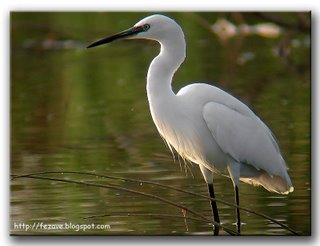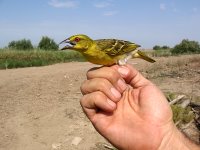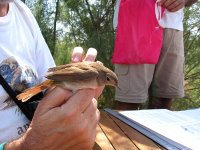CERRO DE LAS CIGÜEÑAS (Foto)

Crónica 10/09/2006
La laguna del Cerro de las Cigüeñas está situada dentro del término municipal de Los Palacios (Sevilla), a 2 km. De éste municipio y 6 km. Del Brazo del Este. Hoy me he acercado junto con Diego para ver que tal estaba de limícolas. Antes del amanecer teníamos montado el hide a unos metros de una playa de arena ideal para éstas aves. Amaneció y pronto empezaron a llegar pájaros, sobre todo Chorlitejo chico y Chorlitejo Grande, estuvimos haciendo fotos a algunas especies, pero la verdad es que esperábamos que entrasen otro tipo de limícolas menos habituales, pero bueno, no estuvo mal la cosa, pudimos ver muchas especies y hacer bastantes fotos. Sobre las 11,00 h. nos acercamos hasta un pequeño observatorio que hay en la laguna, pudiendo comprobar que allí había muchos más pájaros que donde nos habíamos puesto con el hide, así que hemos decidido regresar otro día y poner el hide cerca del observatorio. Regresamos hasta donde teníamos el hide, lo recogimos todo y nos fuimos en el coche a dar un paseo por el Brazo del Este. Llegamos hasta La Margazuela y no vimos gran cosa, así que decidimos dirigirnos hacia La Hermosilla, pero en el camino nos encontramos a unos colegas de GOSUR que estaban anillando, así que ya no fuimos a La Hermosilla y nos quedamos con ellos hasta que regresamos a Sevilla.
The lagoon of the Cerro de las Cigüeñas is placed inside the municipal term of Los Palacios (Seville), to 2 km. of this one municipality and 6 km from Brazo del Este. Today I have approached together with Diego to see that such it was of shorebirds. Before the dawn we had the hide mounted to a few meters of a beach of ideal sand for these birds. It dawned and soon birds started coming, especially Little Ringed Plover and Great Ringed Plover, we were doing photos to some kinds, but the truth is that we were hoping that they were approaching another type of shorebirds less habitually, but well, it was not bad the thing, we could see many kinds and do enough photos. On 11:00 am. we approach up to a small observatory that exists in the lagoon, being able to verify that there there were many more birds that where we had put with the hide, so we have decided to return another day and to put the hide near the observatory. We return up to where we had the hide, we gathered everything and went away in the car to giving a walk along the Brazo del Este. We come up to La Margazuela and we did not see great thing, so we decide to go towards La Hermosilla, but in the way we were to a few colleagues of GOSUR (Ornithological group of the south)who were ringing birds, so already we did not go to La Hermosilla and remain with them until we return to Seville.



ANILLADORES DE GOSUR (Grupo Ornitológico del Sur)
La primera foto es de un Tejedor (Ploceus cucullatus), que me comentaron que era la primera vez que capturaban a este tejedor. La segunda foto es de una hembra de Tejedor (Euplectes afer) y la tercera foto es de un Ruiseñor común(Luscinia megarhynchos).
Ringers of GOSUR (Ornithological group of the south)
The first photo belongs to a Yellow crowned-Bishop (Ploceus cucullatus), that they commented to me that it was the first time that they were capturing this weaver. The second photo belongs to a female of Village Weaver (Euplectes afer) and the third photo is of a Rufous Nightingale (Luscinia megarhynchos ).
En fin, hemos pasado una mañana muy entretenida y con muchísimo calor. He podido observar las siguientes especies:
In purpose, we have happened one very entertaining morning and with a lot of heat. I could have observed the following kinds:
Zampullín Común Tachybaptus ruficollis Little Grebe
Martinete Común Nycticorax nycticorax Night Heron
Garcilla Cangrejera Ardeola ralloides Squacco Heron
Garcilla Bueyera Bubulcus ibis Cattle Egret
Garceta Común Egretta garzetta Little Egret
Garza Real Ardea cinerea Grey Heron
Cigüeña Blanca Ciconia ciconia White Stork
Morito Común Plegadis falcinellus Glossy Ibis
Flamenco Común Phoenicopterus ruber Greater Flamingo
Cuchara Común Anas clypeata Northern Shoveler
Pato Colorado Netta rufina Red-crested Pochard
Aguilucho Lagunero Occidental Circus aeruginosus Marsh Harrier
Busardo Ratonero Buteo buteo Common Buzzard
Aguililla Calzada Hieraaetus pennatus Booted Eagle
Águila Pescadora Pandion haliaetus Osprey
Cernícalo Vulgar Falco tinnunculus Common Kestrel
Gallineta Común Gallinula chloropus Moorhen
Calamón Común Porphyrio porphyrio Purple Swamp-hen
Focha Común Fulica atra Common Coot
Cigüeñuela Común Himantopus himantopus Black-winged Stilt
Chorlitejo Chico Charadrius dubius Little Ringed Plover
Chorlitejo Grande Charadrius hiaticula Great Ringed Plover
Agachadiza Común Gallinago gallinago Common Snipe
Aguja Colinegra Limosa limosa Black-tailed Godwit
Archibebe Común Tringa totanus Common Redshank
Andarríos Grande Tringa ochropus Green Sandpiper
Andarríos Chico Actitis hypoleucos Common Sandpiper
Gaviota Reidora Larus ridibundus Black-headed Gull
Gaviota Sombría Larus fuscus Lesser Black-backed Gull
Fumarel Cariblanco Chlidonias hybridus Whiskered Tern
Mochuelo Europeo Athene noctua Little Owl
Cogujada Común Galerida cristata Crested Lark
Golondrina Común Hirundo rustica Barn Swallow
Lavandera Boyera Motacilla flava Yellow Wagtail
Collalba Gris Oenanthe oenanthe Northern Wheatear
Buitrón Cisticola juncidis Zitting Cisticola
Carricero Común Acrocephalus scirpaceus Reed Warbler
Carricero Tordal Acrocephalus arundinaceus Great Reed Warbler
Mosquitero Musical Phylloscopus trochilus Willow Warbler
Papamoscas Cerrojillo Ficedula hypoleuca Pied Flycatcher
Gorrión Moruno Passer hispaniolensis Spanish Sparrow
Pico de Coral Estrilda astrild Common Waxbill
Jilguero Carduelis carduelis Goldfinch
Tejedor Euplectes afer Yellow-crowned Bishop
Tejedor Ploceus cucullatus Village Weaver
Cuando regresábamos pudimos observar cientos y cientos de Cigüeñas blancas (Ciconia ciconia) posadas en un campo del Brazo del Este.
Eso es todo.
When we were returning we could observe hundreds and hundreds of white Storks (Ciconia ciconia) put in a field of the Brazo del Este.That's all.
Más fotos en http://www.galeriade.com/fezave
More photos in: http://www.galeriade.com/fezave







0 Comments:
Publicar un comentario
<< Home